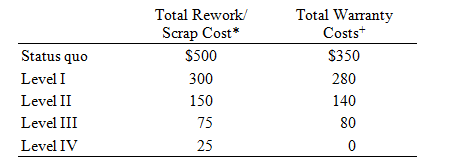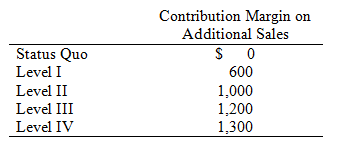Guest Watches is a division of Guest Fashions, a large, international fashion designer. Guest Watches manufactures highly
Question:

* Includes the annual costs of training employees in TQM methods.
+ All annual costs including certifying suppliers, redesigning the product, and inspection costs to reduce defects.
The consultant emphasized that while first-year startup costs are slightly higher than subsequent years, management must really view the cost estimates in the table as annual, ongoing costs. Given employee turnover and the assumption that supplier changes, training, prevention, and compliance costs are not likely to decline over time, the costs in the preceding table will be annual operating expenses. The consulting firm and the newly appointed vice president for quality programs estimated that under level IV, rework and scrap would be $25,000 and warranty costs zero. Level IV was needed to get the firm to zero defects. A task force was convened, and after several meetings, it generated the following estimates of rework/scrap and warranty costs for the various levels of firm commitment:

* The costs of manufacturing scrap and rework. + The costs of repairing and replacing products that fail in the hands of customers. There was considerable discussion and debate about the quantitative impact of increased quality on additional sales. Although no hard-and-fast numbers could be derived, the consensus view was that the total net cash flows (contribution margin) from additional sales as retailers and customers learn of the reduced defect rate would be as follows:

a. Assuming the data as presented are reasonably accurate, what should Guest Watches do about its deteriorating quality situation? Should it maintain the status quo or should it adopt the consultant€™s recommendation and implement Level I, II, III, or IV?
b. Critically evaluate the analysis underlying your policy recommendation in part (a). Will the senior management of the watch division make the same decision as the senior management of Guest Fashions?
Contribution MarginContribution margin is an important element of cost volume profit analysis that managers carry out to assess the maximum number of units that are required to be at the breakeven point. Contribution margin is the profit before fixed cost and taxes...
Step by Step Answer:

Managerial Economics and Organizational Architecture
ISBN: 978-0073375823
5th edition
Authors: James Brickley, Jerold Zimmerman, Clifford W. Smith Jr





